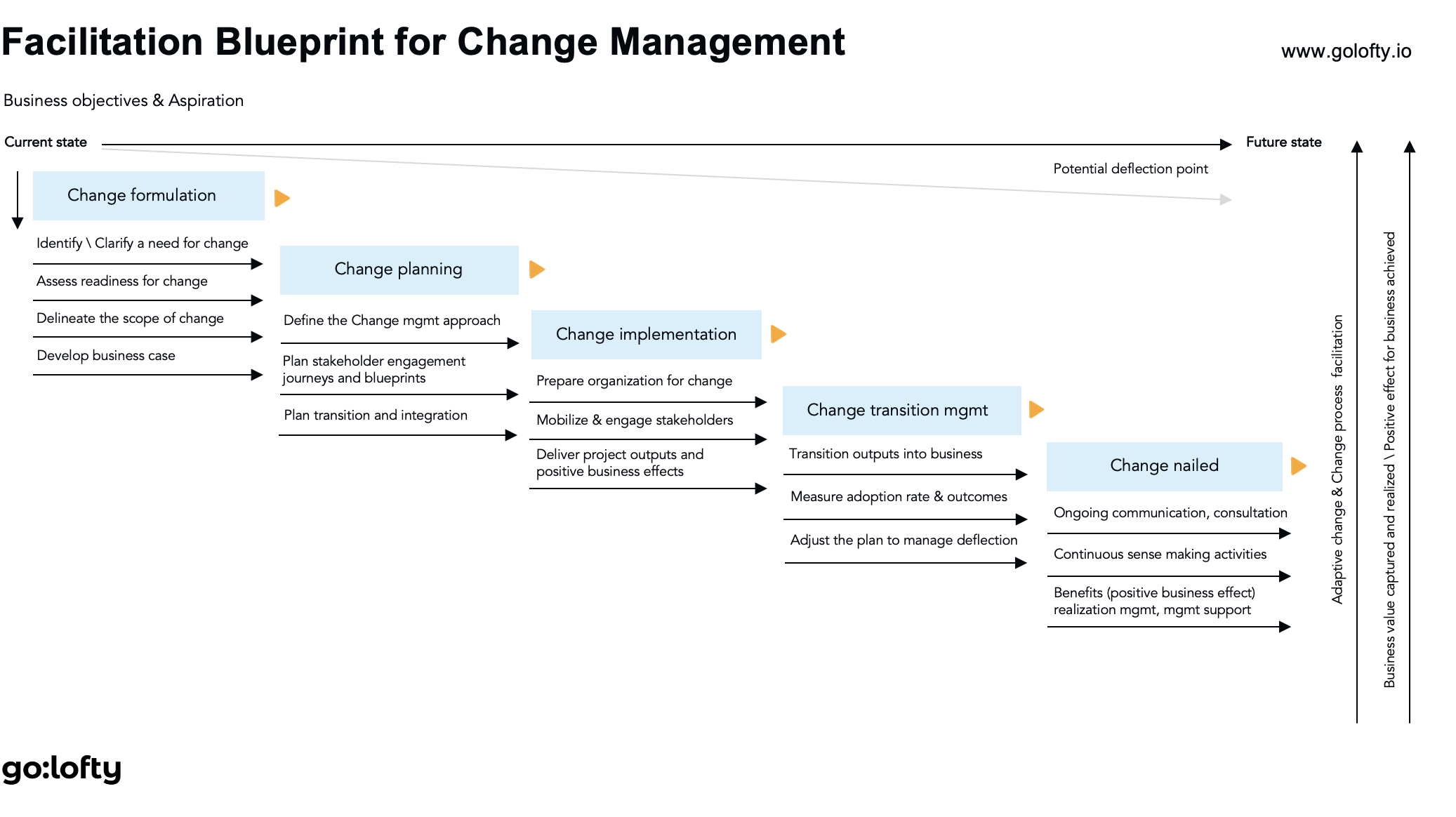
Change has become the defining condition of modern business. From digital disruption and economic volatility to geopolitical shifts and sustainability pressures, organizations are navigating constant turbulence. In this context, the ability to manage and facilitate change effectively is no longer optional — it is a strategic capability.
Yet despite decades of research and frameworks, most change initiatives still fail to deliver their intended outcomes. Studies consistently show that between 60–70% of major transformations either underperform or collapse altogether. The reasons are depressingly familiar: lack of alignment, inadequate leadership sponsorship, stakeholder resistance, poor communication, or a failure to embed new ways of working into the culture.
The challenge is not only what changes but how those changes are facilitated. Facilitation provides the structure, discipline, and engagement necessary to convert aspirations into sustainable outcomes. It is the connective tissue between the strategic intent of the boardroom and the day-to-day realities of frontline teams.
This article presents a Facilitation Blueprint for Change Management, a structured, end-to-end approach that guides organizations through each critical stage of transformation: formulation, planning, implementation, transition, and reinforcement. Designed for executives and transformation leaders, it offers a way to ensure that change efforts don’t just happen — they succeed.
Why Start with Change Formulation?
Every successful change initiative begins with clarity. Without it, organizations risk plunging into execution without understanding the “why,” the “what,” or the “how.” Change formulation lays the foundation by articulating the case for change, assessing readiness, and defining scope.
Why it matters: Leaders often underestimate the power of narrative. Employees need to know not only what is changing but also why now and why this matters. A clear formulation prevents cynicism and confusion while aligning executive stakeholders around a shared intent.
What it requires:
Identify the need for change: Triggers can be external (new regulations, market shifts, emerging technologies) or internal (inefficiencies, leadership transitions, innovation opportunities). The first step is simply recognizing and naming the need.
Assess readiness: Organizations vary in their appetite and capacity for change. Leaders must gauge cultural resilience, stakeholder openness, and resource availability. Attempting to impose transformation on an unprepared organization is a recipe for resistance.
Define scope: Change without boundaries overwhelms. Leaders must clarify whether the change affects processes, technology, structures, or culture — and to what extent.
Build the business case: This is the most decisive step. Executives and boards expect numbers, not slogans. The business case must quantify expected benefits, outline risks, and demonstrate ROI. Without it, sponsorship will be weak and funding uncertain.
Example: A global pharmaceutical company facing mounting compliance costs identified the need to overhaul its regulatory systems. By conducting a readiness assessment, leaders realized that the culture was highly process-driven but resistant to digital adoption. The scope was defined as “compliance processes and reporting,” not the entire enterprise. The business case showed a projected 20% reduction in compliance costs. This clarity secured board approval and set realistic expectations.
Key lesson: Skip or rush formulation, and change becomes a slogan. Get it right, and you build the foundation for momentum.
How Does Planning Translate Vision into Execution?
Once the need and scope are defined, planning converts aspiration into a roadmap. Too often, organizations move directly from vision to action without designing the journey. This creates misalignment and chaos.
Why it matters: Planning is not about creating thick binders of Gantt charts. It is about making deliberate choices on approach, stakeholder engagement, and integration.
What it requires:
Define the change management approach: Whether using Kotter’s 8 Steps, ADKAR, agile transformation models, or a hybrid, the methodology must fit the organization’s culture.
Map stakeholder journeys: Not all stakeholders are equal. Identify champions, influencers, and potential resistors. Create tailored engagement blueprints, ensuring communication is two-way, not one-way.
Plan integration: Timelines, resourcing, and risk management must be explicit. Leaders should anticipate friction points and design mitigation strategies in advance.
Example: A SaaS company introducing AI-driven analytics to its sales force built a stakeholder blueprint that included sales leaders as early co-creators. Their concerns about job displacement were addressed directly. As a result, adoption rates exceeded 80% within three months.
Key lesson: Planning is where change becomes predictable. Without it, execution becomes firefighting.
What Makes Implementation Successful?
Implementation is the visible face of change. It is where credibility is won or lost. Despite careful planning, many initiatives stall here due to poor facilitation.
Why it matters: Implementation is not about deploying a system or announcing a policy. It is about creating tangible, positive business effects that validate the business case.
What it requires:
Prepare the organization: This includes not only training but psychological preparation. Employees must understand roles, expectations, and benefits.
Mobilize stakeholders: Empower change champions who advocate within their teams. Peer-to-peer influence is often more persuasive than leadership mandates.
Deliver outputs and outcomes: Projects are judged not by activity but by results. Leaders must ensure the promised outputs — new processes, systems, structures — translate into measurable performance gains.
Example: A European bank implementing digital KYC (Know Your Customer) procedures prepared employees with simulations and scenario-based training. Branch managers were mobilized as champions, reinforcing confidence. As a result, customer onboarding time was reduced by 40%, demonstrating immediate business value.
Key lesson: Implementation is not the end. It is the first proof point of credibility.
Why Is Transition Management Critical After Go-Live?
Organizations often declare victory at go-live, only to watch adoption lag. Transition management ensures that change does not fade but embeds into the fabric of daily operations.
Why it matters: If employees revert to old habits, the change collapses. Sustained facilitation is essential to prevent backsliding.
What it requires:
Embed outputs into operations: Make new processes “business as usual.”
Measure adoption: Use KPIs to track real behavior change, not just system rollout.
Adjust for deviations: No plan survives contact with reality. Leaders must be agile, addressing obstacles and refining processes.
Example: A telecom company rolling out a new CRM initially faced adoption issues. By monitoring usage dashboards, leaders identified underperforming teams, provided targeted retraining, and improved the user interface. Adoption climbed to 95% within six months.
Key lesson: Transition is where change is won or lost. Sustained measurement and adjustment turn temporary shifts into permanent outcomes.
How Do Organizations Ensure Change Is Truly Embedded?
The final stage of the blueprint is reinforcement — ensuring the change matures into culture and delivers ongoing value.
Why it matters: Benefits are often eroded over time. Without reinforcement, organizations slide back into old patterns.
What it requires:
Ongoing communication: Leaders must continue telling the story of change — why it matters, how it connects to strategy, and how it benefits employees.
Sense-making: Periodic reflection helps organizations learn. Which parts worked? Which failed? These lessons build a playbook for future changes.
Benefit realization: The ultimate measure of success is whether the promised business value materializes. This requires tracking KPIs over the long term and ensuring accountability.
Example: A pharmaceutical firm institutionalized “change audits” six months after every transformation. These reviews measured benefits realized, identified gaps, and documented lessons. Over time, this practice created a culture where continuous change was normalized, not resisted.
Key lesson: Reinforcement transforms change from an event into a capability.
What Business Value Does the Facilitation Blueprint Deliver?
Organizations that adopt this structured approach capture value in multiple dimensions:
Financial performance: Initiatives deliver ROI because they are tied to business cases and measured outcomes.
Organizational alignment: Cross-functional stakeholders remain engaged and aligned throughout the process.
Adaptability: Lessons learned are institutionalized, improving the ability to manage future changes.
Employee engagement: Transparent communication and stakeholder involvement reduce resistance and build trust.
McKinsey research shows that companies embedding structured change management practices are 1.5x more likely to outperform peers financially. The Facilitation Blueprint converts transformation from risk into opportunity.
Closing Thought: Change as a Strategic Capability
Change is no longer episodic — it is continuous. Companies that treat it as a project risk fatigue and failure. Companies that treat it as a capability gain resilience, adaptability, and competitive advantage.
The Facilitation Blueprint provides a structured way to turn aspiration into execution, execution into adoption, and adoption into sustained business value. For executives, the imperative is clear: facilitation is not a soft skill but a hard strategic discipline.
At Go:lofty Consulting, we help leaders design and facilitate change with precision, ensuring that every transformation delivers measurable business impact.
Go:lofty bonus content
1. Why do most change management initiatives fail?
The majority of initiatives fail because organizations underestimate the human and cultural dimensions of change. Leaders often focus on technical rollout (systems, processes) but neglect stakeholder engagement, readiness assessments, and reinforcement. Without clear sponsorship and sustained facilitation, employees revert to old behaviors. Success comes from aligning the “hard” (systems, KPIs, processes) with the “soft” (mindsets, culture, trust).
2. What is the role of facilitation in change management?
Facilitation is the structured process of guiding people through change. It creates the bridge between strategy and execution. Good facilitation ensures that:
The need for change is clearly articulated.
Stakeholders are engaged and mobilized.
Resistance is addressed openly.
Systems and processes are adapted to support new ways of working.
Without facilitation, change feels imposed; with it, change feels navigable.
3. How do you build a strong business case for change?
A credible business case connects the change initiative directly to measurable outcomes. This requires:
Defining the problem or opportunity.
Quantifying expected benefits (cost savings, revenue growth, risk reduction).
Assessing risks and resource needs.
Showing alignment with corporate strategy.
Executives and boards approve change when they see both financial ROI and strategic relevance. A weak or vague case is the fastest route to stalled initiatives.
4. How do you overcome resistance to change?
Resistance is natural. The key is not to suppress it but to surface and address it. Practical steps include:
Involving stakeholders early as co-creators, not late as recipients.
Communicating the “why” behind the change.
Providing psychological safety — space to voice concerns without penalty.
Identifying change champions who influence peers.
When resistance is acknowledged and addressed, it often transforms into advocacy.
5. How should leaders measure the success of change?
Traditional project milestones (on time, on budget) are insufficient. Success must be measured in terms of:
Adoption: Are employees using the new processes or systems consistently?
Behavioral change: Are desired new ways of working visible in daily operations?
Business outcomes: Has the initiative delivered the promised ROI, efficiency, or customer impact?
Effective change measurement is continuous, not a one-time post-mortem.
6. What are the key stages of a successful change process?
A structured blueprint includes five stages:
Formulation — identify need, assess readiness, build the business case.
Planning — design approach, stakeholder journeys, integration plan.
Implementation — prepare, mobilize, and deliver outputs.
Transition — embed outputs into operations, measure adoption, adjust.
Reinforcement — sustain communication, realize benefits, institutionalize lessons.
Skipping stages undermines credibility and adoption.
7. How can organizations sustain change over the long term?
Sustainability depends on reinforcement. Leaders must:
Continue communicating the benefits and linking them to strategy.
Track KPIs that reflect outcomes, not just activity.
Institutionalize lessons through post-change reviews.
Build change capability into culture, so transformation is continuous rather than episodic.
Companies that view change as a capability — not a project — are more resilient.
8. What role do middle managers play in change management?
Middle managers are often the make-or-break layer. They translate strategy into daily operations and shape employee sentiment. If engaged, they act as multipliers of adoption; if ignored, they can stall progress. Best practice is to involve them early, train them as facilitators, and equip them to answer the questions frontline employees will inevitably ask.
9. How can technology support change facilitation?
Technology enables visibility, communication, and measurement. Examples include:
CRM & HR systems to manage adoption data.
Analytics dashboards to track KPIs in real time.
Collaboration tools for stakeholder engagement.
AI-enabled feedback platforms to surface employee sentiment quickly.
Technology does not replace facilitation, but it amplifies it by making progress transparent and actionable.
10. What is the ROI of structured change management?
The ROI shows up in multiple dimensions:
Financial: Faster realization of cost savings, revenue, or compliance benefits.
Operational: Reduced disruption and smoother integration of systems or processes.
Cultural: Higher employee trust and engagement, reducing turnover.
McKinsey analysis shows structured change programs can increase success rates by up to 30–40% compared to ad-hoc efforts. For executives, this means millions in captured value that would otherwise be lost.




